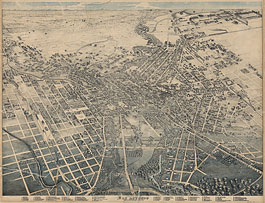San Antonio in 1873
Unlike most Texas bird’s-eye views, Augustus Koch’s depiction of San Antonio does not include a train, because the railroad did not arrive in the Alamo City until 1877. The most obvious aspects of the city, viewed from the northwest, are its many public plazas and the winding San Antonio River. San Fernando Church is located on the west side of the Main Plaza, with the Bexar County Courthouse immediately… [More]
San Antonio in 1886
The railroads were slow to build to San Antonio. In 1877, Galusha Aaron Grow, president of the International-Great Northern Railway, suggested that San Antonio was “perhaps the largest city on the continent today that had remained so long without railroad connection”—and when railroads did arrive on the evening of February 19, 1877, they transformed the “old dry bones of the Alamo City.”
San Antonians had tried to lure a railroad… [More]San Marcos in 1881
San Marcos was still a small, country town when Augustus Koch documented it in December 1880 shortly after the International-Great Northern Railroad, shown on the right-hand side of the print, connected it with Austin and San Antonio. Anglo-American settlers had arrived at the site in the 1840s, and the city had developed as a regional milling and ginning center. Cattle and cotton had become its main products by 1870… [More]
Schulenburg in 1881
Schulenburg, located in southern Fayette County about eighteen miles south of La Grange, was a small town of fewer than 1,000 persons when Koch visited in 1881. It had been founded in 1873, when the Galveston, Harrisburg and San Antonio Railway built through that portion of the county, and was settled by German, Austrian, and Czech immigrants whose presence is documented in some of the street names such as… [More]
Seymour in 1890
The Seymour that Thaddeus Fowler depicted in 1890 seemed to be a prosperous county seat with more large, stone buildings than such a small community, which was not even listed separately in the census of 1890, might justify. The substantial buildings resulted from a boom that coincided with the construction of the Wichita Valley Railroad to Seymour, located on the Brazos River, in 1890. The boom began when the… [More]















